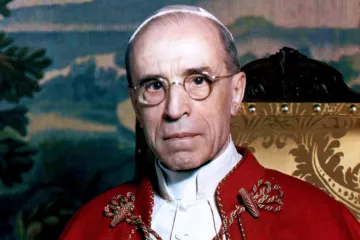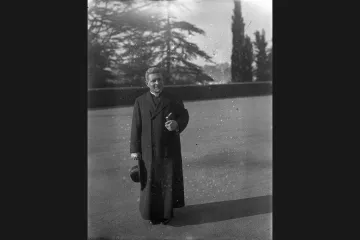Denver Newsroom, Jun 23, 2022 / 18:00 pm
Relatives of Holocaust survivors and victims can now look through the files of more than 2,700 Jews who sought help through Vatican channels to escape Nazi persecution before and during the Second World War. The archives have gone public on the internet at the request of Pope Francis.
The files constitute “a heritage that is precious because it gathers the requests for help sent to Pope Pius XII by Jewish people, both the baptized and the non-baptized, after the beginning of Nazi and fascist persecution,” Archbishop Paul Richard Gallagher, Secretary for Relations with States and International Organizations, said in a June 23 article for Vatican News.
This heritage is “now easily accessible to the entire world thanks to a project aimed at publishing the complete digitalized version of the archival series,” he said. “Making the digitized version of the entire Jews/Jewish people series available on the internet will allow the descendants of those who asked for help, to find traces of their loved ones from any part of the world. At the same time, it will allow scholars and anyone interested, to freely examine this special archival heritage, from a distance.”
The files are hosted at the website for the Historical Archive of the Secretariat of State’s Section for Relations with States and International Organizations. The archive hosts a photographic reproduction of each document and an analytical inventory that names all those requesting help.
The series pertains to the papacy of Venerable Pius XII, who was elected pope on March 2, 1939, just six months before the start of the war.
Some requests written by Jews or on behalf of Jews sought help to obtain visas or passports, to find asylum, or to reunify families. Others sought freedom from detention or transfers to a different concentration camp. They sought news of deported people or asked for supplies of food or clothes, financial support, spiritual support, and more.
Requests went through the Secretariat of State, and Church diplomatic channels would try to provide “all the help possible,” said Gallagher.
In 2020, when this archive was first opened to researchers, Vatican officials described the documents as “Pacelli’s List,” using the family name of Pope Pius XII to allude to the “Schindler’s List” of the Stephen Spielberg film about a German who rescued Jews from the Holocaust.
“Although the two cases differ, the analogy perfectly expresses the idea that people in the corridors of the institution at the service of the pontiff, worked tirelessly to provide Jewish people with practical help,” Gallagher said.
Critics of Venerable Pius XII have said he did not do enough to oppose Nazism or to help Jews during the Holocaust. His defenders point to the pope’s record before and during the war, including significant evidence of Vatican assistance for Jews and others persecuted by the Nazis.
The archive series is 170 volumes in total, about 40,000 digital files. About 70% of the material will be made available immediately, but the final volumes are still being integrated into the collection, the Holy See Press Office said in a June 23 bulletin published in the English, Italian, and Hebrew languages.
Most of the Secretariat of State’s foreign relations files were named for geographical subjects, not for a race or religion of people. The Ebrei Archival Series was named “Jews” or “Jewish people” in Italian because “its aim is to preserve the petitions for help from Jewish people all over Europe, received by the Pope during the Nazi-Fascist persecutions,” the press office said.
In the mid-20th century, the Section for Relations with States was known as the Congregation for Extraordinary Ecclesiastical Affairs, equivalent to a Ministry of Foreign Affairs. Msgr. Angelo Dell’Acqua had a diplomatic role in this office called minutante. He and his office oversaw requests from Jews and sought “to provide the petitioners with all possible assistance,” the archive page says. Dell’Acqua would later become a cardinal and vicar-general of Rome under St. Paul VI.
Some of the Jews who wrote seeking Catholic aid were baptized Christians, but many were not. Many petitions were written by intermediaries on behalf of Jews.
“Thousands of people persecuted for their membership to the Jewish religion, or for merely having ‘non-Aryan’ ancestry, turned to the Vatican, in the knowledge that others had received help,” said Gallagher.
Gallagher’s article in Vatican News recounted the case of Werner Barasch, a 23-year-old German university student of Jewish background who was baptized in 1938. His historic file has documents from his effort to be released from a concentration camp in Spain. On Jan. 17, 1942 Barasch wrote to an Italian friend and asked her to seek the intervention of Pius XII through the apostolic nuncio in Madrid.
(Story continues below)
Barasch wrote: “with this intervention from Rome, others had been able to leave the
concentration camp.” He said he had hoped to join his mother who had fled to the U.S. in 1939 “to prepare a new life for me.” He needed the help “of someone from outside” so that the authorities would grant his release.
“There is little hope for those who have no outside help,” said Barasch’s letter.
The Vatican file shows the Secretariat of State addressed the case in a few days’ time and “newly” brought it to the attention of the nuncio to Spain. There is nothing more to the paper trail. Like the majority of cases, the Vatican files say nothing about what happened to Barasch.
“In our hearts, we immediately inevitably hope for a positive outcome, the hope that Werner Barasch was later freed from the concentration camp and was able to reach his mother overseas,” Gallagher said.
This hope was fulfilled. Barasch was a known Holocaust survivor who recounted his story at the age of 82 in a video interview now at the online collections of the U.S. Holocaust Museum. He was released from the Spanish camp a year after his appeal to the Pope. In 1945, he was able to join his mother in the U.S. He studied at the University of California, Berkeley, the Massachusetts Institute of Technology, and the University of Colorado before working as a chemist in California.
“As for the majority of requests for help witnessed by other cases, the result of the request was not reported,” Gallagher said.
About 6 million Jews were murdered in the Holocaust.
On June 22, Pope Francis received an international delegation of the Simon Wiesenthal Center, an international Jewish human rights group that counts 400,000 member families in the U.S. The delegation presented to the pope a copy of an original report authored and signed by Nazi leader Adolph Hitler in which he called for the destruction of the Jewish people. The document is dated Sept. 16, 1919, long before the Nazis took power.
“What began as one man’s opinion would become state policy of Nazi Germany 22 years later, which led to the systematic murder of one-third of world Jewry,” Marvin Hier, founder and CEO of the Simon Wiesenthal Center, said at the meeting. “This document shows the power of words and is a warning for everyone to take threats of any demagogue seriously.”
Hier noted anti-Semitic attacks on both sides of the Atlantic, which the Simon Wiesenthal Center said confirm “surging anti-Semitism.”
He also used his remarks to criticize a deal with Iran on nuclear weapons, which the Vatican has supported. Hier also criticized the Russian invasion of Ukraine, charging that Russia was adopting the same tactics as Hitler’s Germany.
The pope accepted the gift of the historic document, which will be placed in the Vatican Archives.
In his remarks, Pope Francis stressed the importance of “recalling history so it can be of service to the future.” He denounced anti-Semitic attacks. According to the Simon Wiesenthal Center, he said the 1919 letter from Hitler showed that the Nazi leader did not care about the German people but only about promoting a dangerous ideology.





